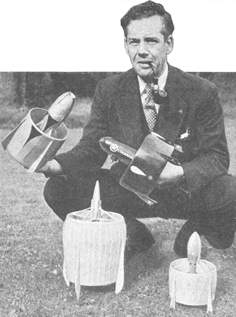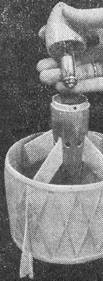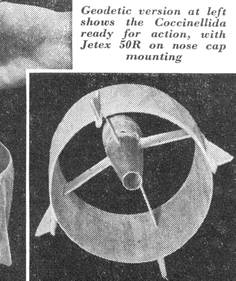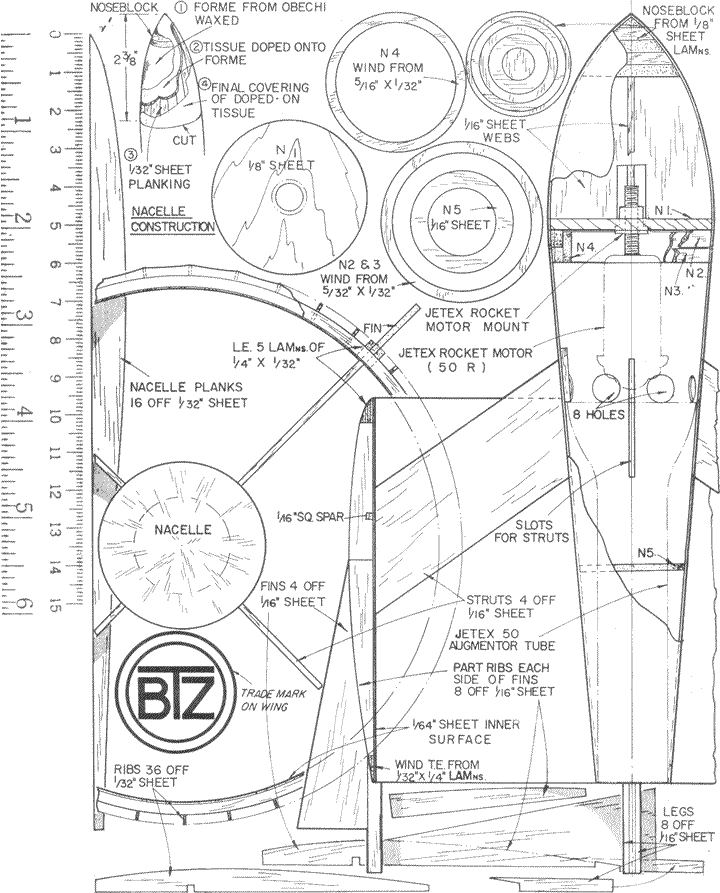|
|
|
|||
|
|
||||
|
|
||||
| Plan: Coccinellida | ||||
|
|
HOME | SITE MAP | FORUM | CONTACT |
|
||
|
ABOUT | MOTORS | MODELS | ARCHIVE | HISTORY | STORE | FAQ | LINKS
|
|
|
|
||||||||||||||
|
Coccinellida
A vertical rising Coleopter for Jetex 50R by Ian Geddes Reprinted from Aeromodeller, Nov. 1956, p. 590 THE BUREAU TECHNIQUE ZBOROWSKI, otherwise known as BTZ, at Brunoy in France, is a remarkable institute currently engaged, in the development of vertical rising annular wing aircraft. Led by technicians with considerable research background in the German Jet and Guided Missile industry up to the time of Victory in Europe, the BTZ design force has relied greatly upon free-flying models for test purposes: but their plans for the future include both pure jet and airscrew propelled vehicles. It was an article by A. R. Weyl, A.F.R.Ae.S. (whose “Dart” aircraft designs, notably the Kitten, are such favourites with scale modellers), in Flight of June 24th, 1955, which created much envelope and table cloth sketching in a certain Dublin coffee shop. The culprit was Ian Geddes, aided by Louis Finucane, whose initial inspirations were soon to take shape just as quickly as they could obtain a sheet of Professor Weyl detailed the Coleopter so well in his “Without visible means of support” article that Ian was able to report success at the first firing of his model experiment: but quite obviously it was simply a straight up-and-down flight trajectory, and in the interests of science, and further experiment, he decided to strike directly at the BTZ headquarters for guidance on one or points. Back came more than expected. Data on model flight, thrust required, etc., and all from none other than Dipl.-Ing. H. v. Zborowski himself. Clearly the answer to success was to build a variety of designs, as the heading photograph [above right] will show, and of the models, the little Coccinellida (Ladybird) with a Jetex Rocket motor gave the most inspiring flights. Without remote control one cannot expect transition to level gliding flight, although this is the ultimate aim, and may yet come with canard and other double ring-wing creations. Coccinellida will, however, make a spectacular ascent to more than 70 ft., and because of the light structure and crashproof sliding fit of the central nacelle on its four support struts, it never comes to any harm if it lands on grass. |

- Aeromodeller, Nov. 1956 (p. 590)
|
||||||||||||||

A tin, saucepan or similar drum is suitable for making the wing, diameter not being critical although the support struts have to be adjusted for any change. Cut When assembled, the nacelle is not a fixture in the wing, but should be capable of sliding under pressure to take collision shock. Balance can be adjusted to bring the C.G. at 5 per cent. Chord, and experiment has shown that for V.T.O. the augmenter tube orifice should be less than 1 in. from the ground surface. Fit a piece of d/t fuse on the igniter wick, light up and plug the nose cap mounted 50R on the nacelle—then stand back. The result is amazing!!! For full rocket boost, cut the fuel as described in “Motor Mart”, April issue, 1955. |
|

- Aeromodeller, Nov. 1956 (p. 590)
|
|||||||||||||
|
|
|
||||||||||||||
Plan for Coccinellida
(A larger copy of the plan is also available to
view or download). |
|||||||||||||||
|
|
|
||||||||||||||
|
|
|
|
|
|
|
|
Acknowledgements - Article and plan contributed by Bill Henderson |
|
|
|
|
ABOUT | MOTORS | MODELS | ARCHIVE | HISTORY | STORE | FAQ | LINKS |
|
|
Terms of Use
|
Queries? Corrections? Additions?
Please
contact us.
|
|